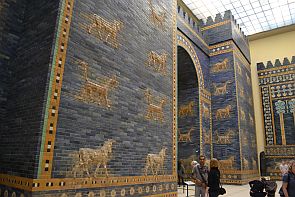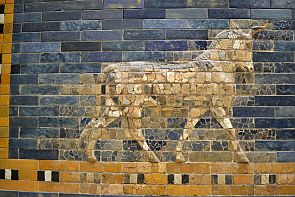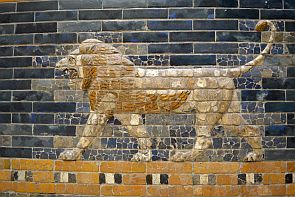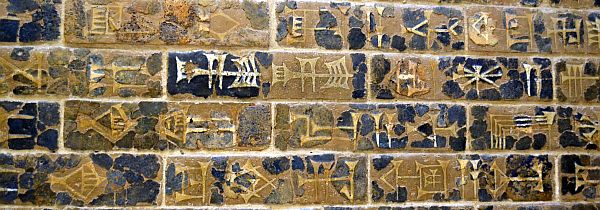|
 Ishtar Gate, Berlin, Germany
N 52° 31.260 E 013° 23.794
33U E 391209 N 5820196
A mosaic that used to be one of the Seven Wonders of the World
Waymark Code: WMKEJQ
Location: Berlin, Germany
Date Posted: 03/31/2014
Views: 14
|
Up until the 3rd century BC, the Walls of Babylon were considered one of the Seven Wonders of the World (later, the Lighthouse of Alexandria took their place). And while the walls and their eight gates are already impressive in their own rights, the Mosaic at the
Ishtar Gate takes "impressive" to a totally new level.
|
|
The gate is 47 feet high and 100 feet wide (14m x 30m) and its front is made of glazed bricks put together to make 21 images of aurochs (to symbolize the weather god Adad) and 21 mystical animals called Mušhuššu (to symbolize Marduk, God of Fertility and Patron God of Babylon).
The mosaic continues along the adjacent processional street with pictures of lions. |
|

|
|
Though the bricks are larger than "normal" mosaic pieces, we believe the term mosaic still applies as it takes 120 bricks for each animal. After all, the entire ensemble consists of roughly 20,000 individual pieces.
|

 |
|

Aurochs and lion were holy animals in Babylon. The Mušhuššu was a mythical gatekeeper, a scaly dragon with hind legs like an eagle's talons, feline forelegs, a horned head and a snakelike tongue.
All pictures were framed by flowers and other ornaments, making up an impressive design which back then must have been one of the largest mosaics of the world.
|
|
The gate was built during the reign of king Nebuchadnezzar II (605–562 BC). The downfall of the town began shortly after Nebuchadnezzar's death, and by 100 AD, only ruins were left.
Excavation by German archaeologists started in 1897 and between 1899 and 1927, 799 crates with bricks were shipped to Berlin, where they were put back together and presented to the public in 1930.
Today, it is one of the key exhibits of Berlin's Pergamon Museum. You can find all relevant information about this museum at the nearby waymark.

In addition to impressive pictures, the gate also presents one of the oldest examples of human writing - a dedication by the king at the left side of the gate.
|
Specific visit requirements:
The Pergamon Museum is open daily from 10 AM to 6 PM, admission is 12 Euro.
Check the museum's website for more information
http://www.smb.museum/en/museums-and-institutions/pergamonmuseum/home.html

Address:
Pergamon Museum
Bodestraße 1-3
Berlin, Berlin Germany
10178

Related web site: [Web Link]

|
Visit Instructions:
To visit a waymark listed in this category, please add to your log a picture taken by you. To complete this basic visit requirement, each owner is free to propose particular visit requirements (see optional variable) if you can't provide a picture.
|